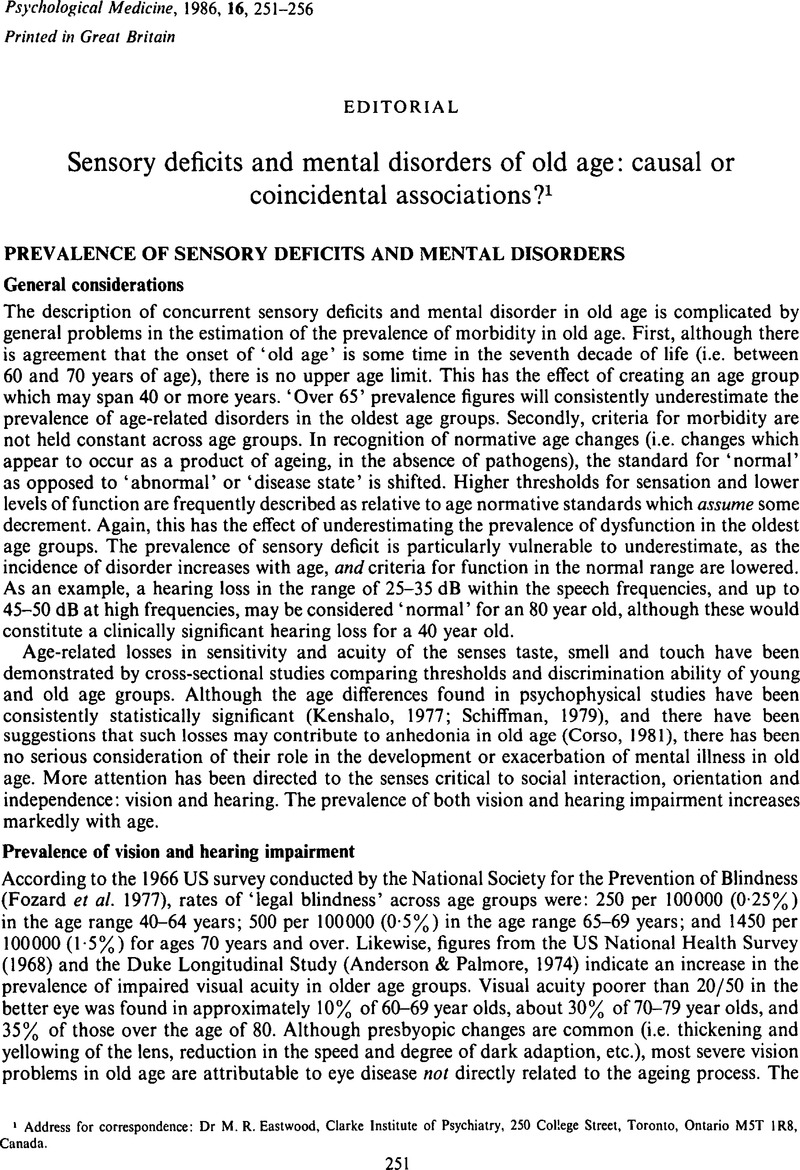Crossref Citations
This article has been cited by the following publications. This list is generated based on data provided by Crossref.
Eastwood, Robin
and
Corbin‐Rifat, Sandra
1987.
Hearing impairment, mental disorders and the elderly.
Stress Medicine,
Vol. 3,
Issue. 3,
p.
171.
Eastwood, MR
and
Rifat, Sandra
1987.
More on the Association Between Hearing and Cognitive Impairment.
Journal of the American Geriatrics Society,
Vol. 35,
Issue. 9,
p.
888.
Pearlson, Godfrey
and
Rabins, Peter
1988.
The Late-Onset Psychoses.
Psychiatric Clinics of North America,
Vol. 11,
Issue. 1,
p.
15.
Uhlmann, Richard F.
Rees, Thomas S.
Psaty, Bruce M.
and
Duckert, Larry G.
1989.
Validity and reliability of auditory screening tests in demented and non-demented older adults.
Journal of General Internal Medicine,
Vol. 4,
Issue. 2,
p.
90.
Snowdon, D A
Kane, R L
Beeson, W L
Burke, G L
Sprafka, J M
Potter, J
Iso, H
Jacobs, D R
and
Phillips, R L
1989.
Is early natural menopause a biologic marker of health and aging?.
American Journal of Public Health,
Vol. 79,
Issue. 6,
p.
709.
Eastwood, MR
and
Corbin‐Rifat, SL
1989.
Is the Hearing‐Impairment/Dementia Relationship Impaired?.
Journal of the American Geriatrics Society,
Vol. 37,
Issue. 5,
p.
489.
1989.
A chart review study of late-onset and early-onset schizophrenia.
American Journal of Psychiatry,
Vol. 146,
Issue. 12,
p.
1568.
Shearer, Donald E.
Emmerson, Rita Y.
and
Dustman, Robert E.
1989.
EEG Relationships to Neural Aging in the Elderly: Overview and Bibliography.
American Journal of EEG Technology,
Vol. 29,
Issue. 1,
p.
43.
Lewis‐Cullinan, Carol
and
Janken, Janice K
1990.
Effect of cerumen removal on the hearing ability of geriatric patients.
Journal of Advanced Nursing,
Vol. 15,
Issue. 5,
p.
594.
Mulsant, Benoit H.
and
Thornton, Joe E.
1990.
Handbook of Outpatient Treatment of Adults.
p.
353.
Janken, Janice K.
and
Cullinan, Carol Lewis
1990.
Auditory Sensory/Perceptual Alteration: Suggested Revision of Defining Characteristics.
International Journal of Nursing Terminologies and Classifications,
Vol. 1,
Issue. 4,
p.
147.
1991.
Delusions in dementia: a review.
The Journal of Neuropsychiatry and Clinical Neurosciences,
Vol. 3,
Issue. 2,
p.
121.
Flint, Alastair J.
1991.
Delusions, hallucinations and depression in Alzheimer's disease: A biological perspective.
American Journal of Alzheimer's Care and Related Disorders & Research,
Vol. 6,
Issue. 3,
p.
21.
Hassett, Anne M.
Keks, Nicholas A.
Jackson, Henry J.
and
Copolov, David L.
1992.
The Diagnostic Validity of Paraphrenia.
Australian & New Zealand Journal of Psychiatry,
Vol. 26,
Issue. 1,
p.
18.
Almeida, Osvaldo P.
Howard, Robert
Förstl, Hans
and
Levy, Raymond
1992.
Late paraphrenia: A review.
International Journal of Geriatric Psychiatry,
Vol. 7,
Issue. 8,
p.
543.
Almeida, Osvaldo P.
Förstl, Hans
Howard, Robert
and
David, Anthony S.
1993.
Unilateral Auditory Hallucinations.
British Journal of Psychiatry,
Vol. 162,
Issue. 2,
p.
262.
Yu, Lucy C.
and
Wang, Mingi
1993.
Social status, physical, mental health, well-being and self evaluation of elderly in China.
Journal of Cross-Cultural Gerontology,
Vol. 8,
Issue. 2,
p.
147.
Howard, Robert
Almeida, Osvaldo
and
Levy, Raymond
1994.
Phenomenology, demography and diagnosis in late paraphrenia.
Psychological Medicine,
Vol. 24,
Issue. 2,
p.
397.
Kalayam, Balu
Meyers, Barnett S.
Kakuma, Tatsuyuki
Alexopoulos, George S.
Young, Robert C.
Solomon, Sandra
Shotland, Rochelle
Nambudiri, Draupathi
and
Goldsmith, Daniel
1995.
Age at onset of geriatric depression and sensorineural hearing deficits.
Biological Psychiatry,
Vol. 38,
Issue. 10,
p.
649.
Mason, P. R.
and
Winton, F. E.
1995.
Ear disease and schizophrenia: a case‐control study.
Acta Psychiatrica Scandinavica,
Vol. 91,
Issue. 4,
p.
217.



